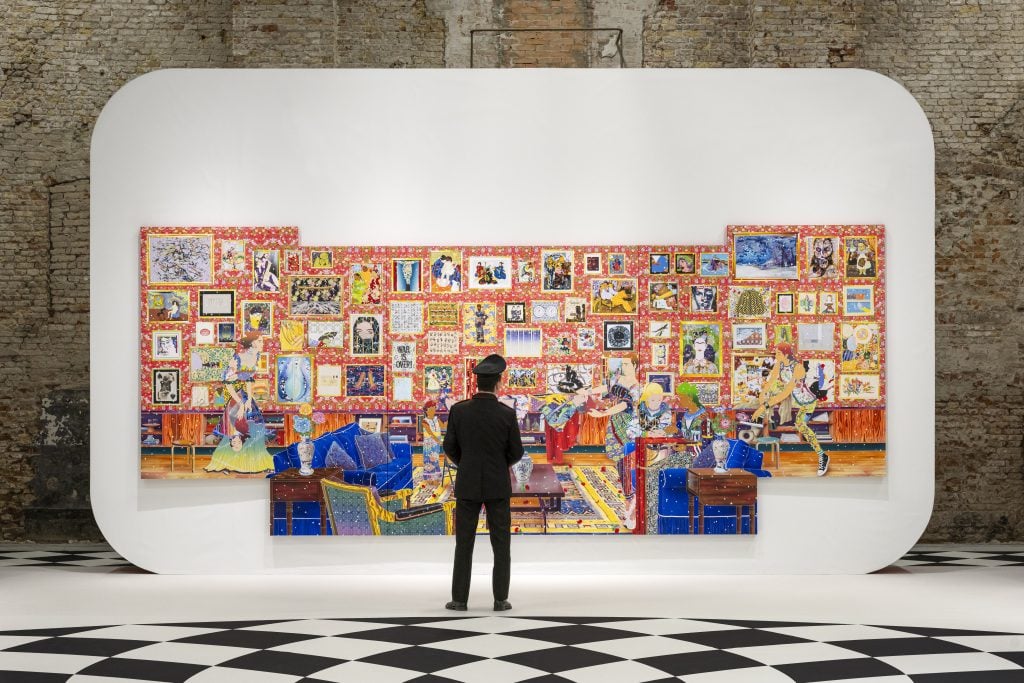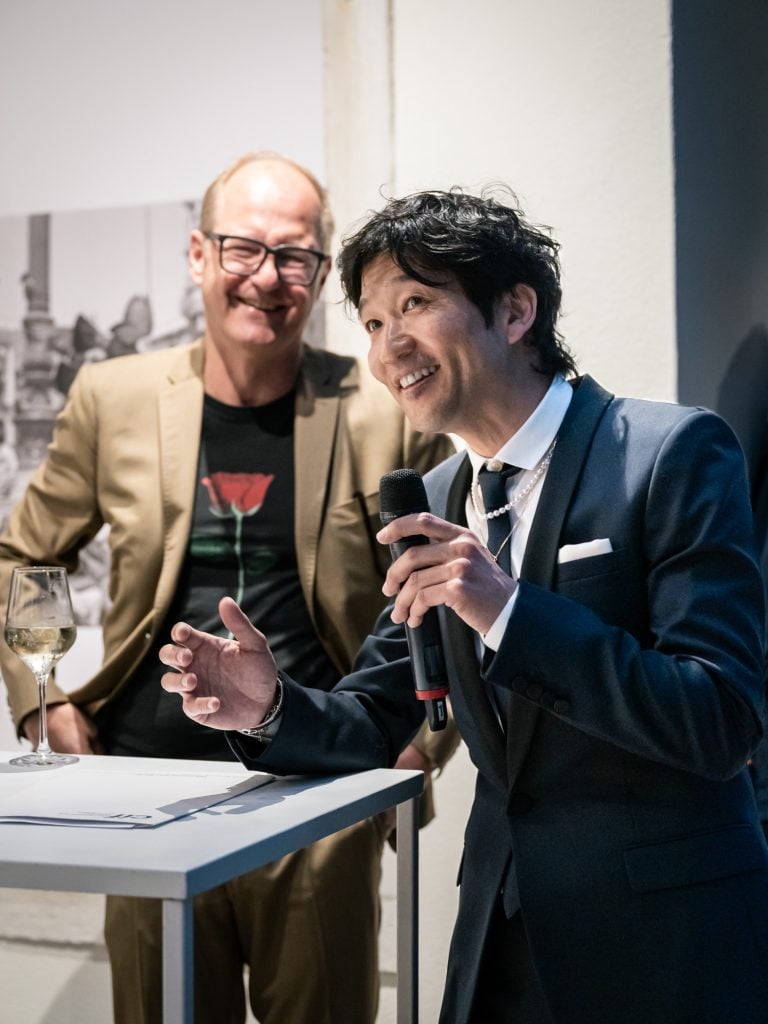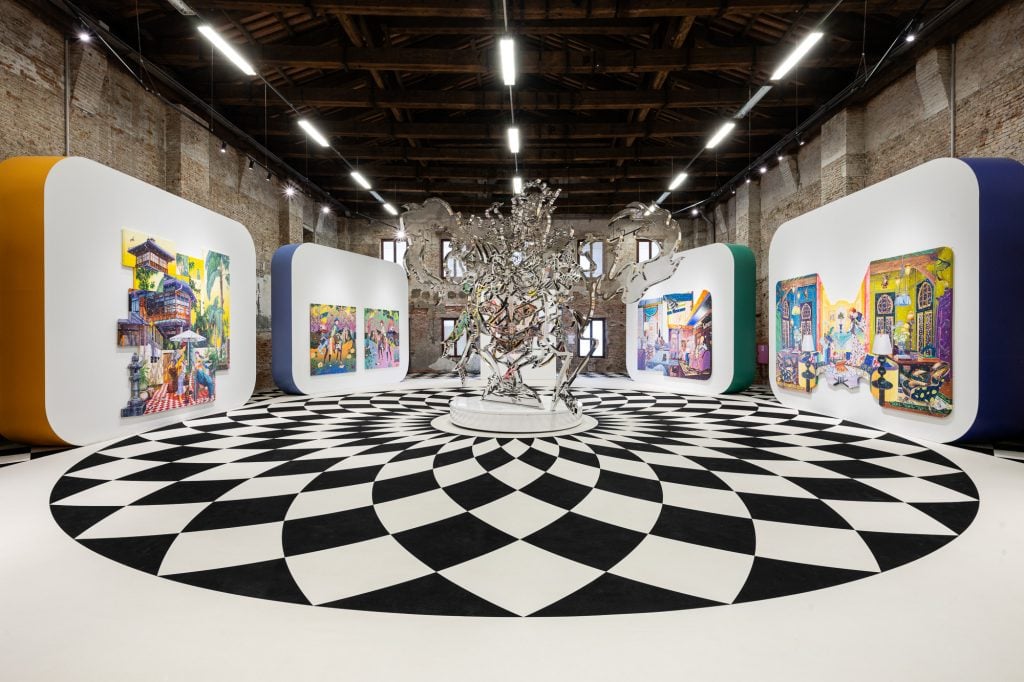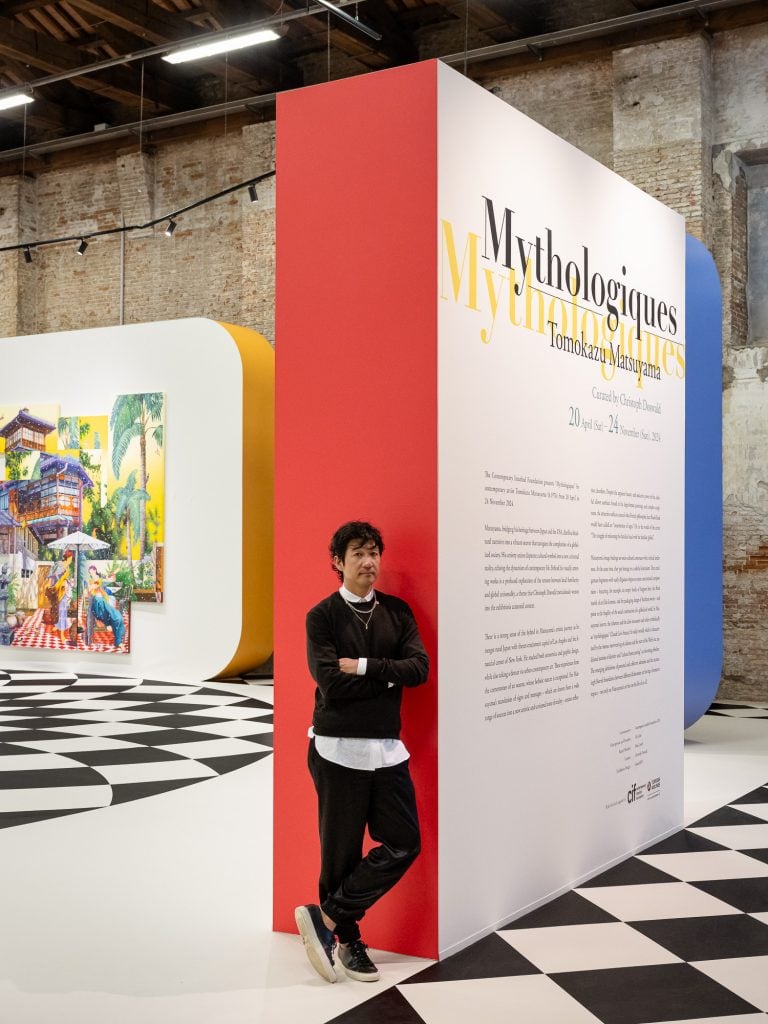Gallery Network
Inside Artist Tomokazu Matsuyama’s Constructed Cosmos, Identity, Culture, and Architecture Converge
We spoke to the artist along with curator Christoph Doswald about the colorful installation "Mythologiques," on view now in Venice.

We spoke to the artist along with curator Christoph Doswald about the colorful installation "Mythologiques," on view now in Venice.

Artnet Gallery Network

Coinciding with the 60th Venice Biennale, Japanese visual artist Tomokazu Matsuyama is the subject of a solo show, “Mythologiques,” staged in the city’s Magazzino No. 41. Curated by Christoph Doswald and organized by the Contemporary Istanbul Foundation, the show highlights the multifaceted and dynamic themes of identity, globalization, and culture—and the myriad ways they intersect, as well as inform one another. Matsuyama’s unique visual language and style presents the intricate relationships that compose our lived experience and perceptions, emphasized by the monumental venue’s architecture, in a manner that is both playful and poignant.
On view through November 24, 2024, we reached out to Matsuyama and Doswald to learn more about what went into bringing this immense exhibition to life, and how their own perspectives have changed through the process.

Artist Tomokazu Matsuyama (front) and curator Christoph Doswald (behind) at the opening of “Mythologiques” (2024). Photo: Francesco Russo.
As the curator for “Mythologiques,” can you tell us a bit about how this collaboration came about, and what drew you to this project?
Christoph Doswald: I am interested in curatorial work on the fringes of the classical art system. Last year, I directed the 4th Industrial Art Biennial in Croatia, where we worked in restaurants, in Roman temples, on the harbor pier, or in empty factories. In Zurich, where I live today, I was responsible for the Public Art program for around 12 years and designed many projects in unusual places. Tomokatsu Matsuyama is a former street artist and has been working in impressive spatial contexts for several years. We immediately hit it off and were able to develop a specific architectural environment for the Arsenale Militare to showcase the eight monumental paintings and the five-meter-high sculpture Black Hole Hunter (2024) as an environment. I normally invite artists to develop works for specific contexts. Here, it was the other way around: we created a curatorially tailored exhibition framework for an existing work. That’s what triggered me.

Installation view of “Mythologiques” (2024). Photo: Francesco Russo. Courtesy of the Contemporary Istanbul.
How would you describe your curatorial process bringing this show together? Did you approach change at all over the course of bringing it to life?
CD: Right from the start, I had the idea for an overall spatial staging, as Matsuyama’s visual worlds open up like windows into a new, globalized media cosmos. Initially, we fancied the plan of using an empty 17th-century church. But that quickly fell through because Matsuyama had too little time to react to this specific spatial situation with new works. You have to know that his painting process is extremely time-consuming and lengthy: he only produces a little over a dozen large paintings a year. So, we approached the project the other way round and looked for a large, empty room in which we could create a completely new setting. Together with Markus Dochantschi, a New York architect who specializes in exhibition spaces, we then spent several weeks developing a spatial idea that combines baroque concepts with digital cultures. At the center stands that large sculpture whose ground plan is based on a compass rose. Eight displays, whose rounded shape is reminiscent of smartphones and carry the images, are arranged concentrically around it. The circular floor, a contemporary echo of the geometric patterns of the Seicento, was very important in this setting.

Artist Tomokazu Matuyama within his solo show “Mythologiques” (2024). Photo: Francesco Russo. Courtesy of the Contemporary Istanbul.
Can you tell us about your experience creating “Mythologiques,” and how it was working with Doswald?
Tomokazu Matsuyama: Creating “Mythologiques” was a deeply rewarding experience that allowed me to engage with Venice’s rich history and the Arsenale’s unique setting. The project explores cultural convergence and fluid identities in a world shaped by constant exchanges. Working with Doswald was invaluable; his curatorial vision aligned seamlessly with the themes I wanted to explore, such as the blending of diverse cultural references and the layering of identities. Doswald’s expertise helped shape the immersive experience of “Mythologiques,” enabling us to design a space where viewers could journey through layered narratives and reflect on their own relationship with cultural heritage. This collaboration fostered a dialogue that honored both the local and the global.
What was most important to you to convey to visitors? What do you hope visitors take away with them?
TM: My goal was to invite visitors into a space where cultural narratives intersect, presenting identity as something fluid and layered. It was important to convey that in today’s interconnected world, we are all shaped by a blend of influences that extend beyond singular definitions, prompting questions like, “How do we represent nationality?” Through visual layering and the interplay of diverse symbols, I aimed to create an experience where viewers could feel immersed in a conversation between the familiar and the foreign. Ultimately, I hope visitors leave with a deeper reflection on their own cultural heritage, seeing identity as an evolving dialogue rather than something fixed.

Tomokazu Matsuyama, Bring You Home Stratus (2024). Courtesy of Matuyama Studio.
With the show now having been on view for several months, has your perception of either your work or the show changed or evolved?
TM: Seeing “Mythologiques” on display over time has given me new insights into the work and its impact. Observing how visitors interact with the layered compositions and cultural symbols has reinforced that, for us today, identity politics is an ever-evolving concept shaped by individual interpretation. The feedback and reflections shared by viewers—especially those from within our communities—have deepened my understanding of how these cultural narratives resonate differently across audiences. This ongoing engagement has underscored the importance of creating spaces that invite reflection and foster dialogue.
Can you see this experience influencing or informing new work? In what ways?
TM: Absolutely, the experience with the exhibition has already begun to shape new directions in my work. As I prepare for my first major solo exhibition in Tokyo next March, I’m inspired to delve deeper into the complex intersections of cultural symbols and contemporary themes, such as America’s influence on Japan and the cultural resistance I observe. This project reinforced the importance of immersive spaces that invite viewers to interpret these layers on their own terms—a concept that will be central to both the visual and conceptual aspects of my upcoming work.

Detail of Tomokazu Matsuyama, You, One Me Erase (2023). Courtesy of Matuyama Studio.
How do you see “Mythologiques” contributing to greater dialogues around global society and ideas of identity?
CD: The title “Mythologiques” was inspired by Claude Lévi-Strauss. Lévi-Strauss understood that a globalized society can only function without cultural hierarchies. The political and social validation of cultural expressions, which is still widespread today, must be questioned. Matsuyama deals with cultural codes that have a wide variety of origins. These appropriations and superimpositions form the basis of an impressive oeuvre that challenges us to stay awake and navigate attentively through the globalized Muzak. In order to be able to discuss identity, one must develop an awareness of origins on the one hand and have enough empathic curiosity on the other so that a dialog with the other remains possible. It is not enough for us to eat hamburgers, sushi and chili con carne and wear Balenciaga. We have to deal with the fundamental structures of social myths in order to understand them. When Matsuyama superimposes the heroism of the conquest of Iwojima on a wood-paneled living room, we are left breathless because we have to realize that the dimension of such historical conflicts extends far into the present.
“Mythologiques” is on view at Magazzino No. 41, Venice, through November 24, 2024.